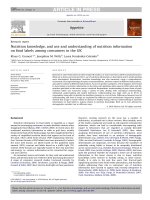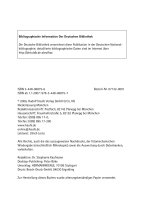Carretta et al risk culture in banking (2017)
Bạn đang xem bản rút gọn của tài liệu. Xem và tải ngay bản đầy đủ của tài liệu tại đây (4.88 MB, 312 trang )
Palgrave Macmillan Studies in Banking and
Financial Institutions
Series Editor
Philip Molyneux
Bangor University, Bangor, UK
The Palgrave Macmillan Studies in Banking and Financial Institutions series is international in
orientation and includes studies of banking systems in particular countries or regions as well as
contemporary themes such as Islamic Banking, Financial Exclusion, Mergers and Acquisitions, Risk
Management, and IT in Banking. The books focus on research and practice and include up to date and
innovative studies that cover issues which impact banking systems globally.
More information about this series at http://www.springer.com/series/14678
Alessandro Carretta, Franco Fiordelisi and Paola Schwizer
Risk Culture in Banking
Alessandro Carretta
University of Rome Tor Vergata, Rome, Italy
Franco Fiordelisi
University of Rome III, Rome, Italy
Middlesex Business School, London, UK
Paola Schwizer
University of Parma, Parma, Italy
Palgrave Macmillan Studies in Banking and Financial Institutions
ISBN 978-3-319-57591-9 e-ISBN 978-3-319-57592-6
/>Library of Congress Control Number: 2017940616
© The Editor(s) (if applicable) and The Author(s) 2017
This work is subject to copyright. All rights are solely and exclusively licensed by the Publisher,
whether the whole or part of the material is concerned, specifically the rights of translation,
reprinting, reuse of illustrations, recitation, broadcasting, reproduction on microfilms or in any other
physical way, and transmission or information storage and retrieval, electronic adaptation, computer
software, or by similar or dissimilar methodology now known or hereafter developed.
The use of general descriptive names, registered names, trademarks, service marks, etc. in this
publication does not imply, even in the absence of a specific statement, that such names are exempt
from the relevant protective laws and regulations and therefore free for general use.
The publisher, the authors and the editors are safe to assume that the advice and information in this
book are believed to be true and accurate at the date of publication. Neither the publisher nor the
authors or the editors give a warranty, express or implied, with respect to the material contained
herein or for any errors or omissions that may have been made. The publisher remains neutral with
regard to jurisdictional claims in published maps and institutional affiliations.
Cover illustration: RooM the Agency/Alamy Stock Photo
Cover design: Samantha Johnson
Printed on acid-free paper
This Palgrave Macmillan imprint is published by Springer Nature
The registered company is Springer International Publishing AG
The registered company address is: Gewerbestrasse 11, 6330 Cham, Switzerland
Contents
1 Introduction
Alessandro Carretta, Franco Fiordelisi and Paola Schwizer
Part I General View: Theory & Tools
2 Risk Culture
Alessandro Carretta and Paola Schwizer
3 Risk Culture in Different Bank Businesses
Marco Di Antonio
4 Risk Culture in the Regulation and Supervision Framework
Alessandro Carretta and Paola Schwizer
5 Internal Controls and Risk Culture in Banks
Doriana Cucinelli
6 People First: Risk Culture Swings into Action
Daniele A. Previati
7 Measuring and Assessing Risk Culture
Nicola Bianchi and Franco Fiordelisi
8 The Impact of Risk Culture on Bank Reputation
Giampaolo Gabbi, Mattia Pianorsi and Maria Gaia Soana
9 Watchdog or Pet Dog: What Is the Role of Media in Shaping Banks’ Risk Culture?
Vincenzo Farina, Lucrezia Fattobene and Elvira Anna Graziano
Part II Good practices, Experiences, Field & Empirical Studies
10 Influence of National Culture on Bank Risk-taking in the European System
Candida Bussoli
11 Risk-Taking of the European Banks in CEECs: The Role of National Culture and Stake Vs
Shareholder View
Federica Sist and Panu Kalmi
12 Banks’ Risk Culture in Residential Mortgage and Cross-Selling Policies: Evidence from the
Euro Area
Umberto Filotto, Claudio Giannotti, Gianluca Mattarocci and Xenia Scimone
13 Supporting an Effective Risk Culture in Private Banking/Wealth Management
Paola Musile Tanzi
14 Attitude Toward Risk and Financial Literacy in Investment Planning
Gianni Nicolini, Tommy Gärling, Anders Carlander and Jeanette Carlsson Hauff
15 Bank Credit Risk Management and Risk Culture
Doriana Cucinelli and Arturo Patarnello
16 Credit Rating Culture
Giacomo De Laurentis
17 Accounting Conservatism and Risk Culture
Alessandro Mechelli and Riccardo Cimini
18 Role of Internal Audit on Risk Culture
Fabio Arnaboldi and Caterina Vasciaveo
Index
List of Figures
Fig. 3.1 A conceptual framework for studying business culture
Fig. 5.1 Internal control system vs Enterprise risk management
Fig. 6.1 A contingency framework for analysing people’s behaviour and risk culture
Fig. 7.1 Mean tw and SRCI ’ growth rate per year
Fig. 9.1 Plots of the BRC index and some of the main financial episodes for different countries over
the time span 1998–2015. The BRC index is plotted for the countries which show a positive and
statistically significant correlation with the financial indicator Nonperforming loans. The time
interval is 1998–2015 except for Ireland (2000–2015). Ireland and The Netherlands present one
missing value in the years 2004 and 2007, respectively
Fig. 12.1 Correlation analysis: real estate mortgages vs. cross selling
Chart 15.1 Sample composition by bank specialization
Chart 15.2 Participants on the survey
Chart 15.3 The increase in the number of CRM staff
Chart 15.4 Number of credit committees in the credit risk management system
Chart 15.5 Number of meetings of risk committees external to the BoD
Chart 15.6 Presence of risk committee separate from the control committee inside the BoD
Chart 15.7 The credit risk models
Chart 15.8 When the CRO attends the board meetings
Chart 15.9 When the CRO attends the executive committee
Chart 15.10 When the CRO attends the risk committee of the BoD
Chart 15.11 The CRO responsibilities in the risk committee
Chart 15.12 The reporting line of the CRO
Chart 15.13 The reporting line of the credit risk manager
Chart 15.14 Credit risk management activity: information to the BoD
Chart 15.15 Credit risk management activity: information to the risk committee within the BoD
Chart 15.16 Credit risk management activity: information to the CRO
Fig. 16.1 May ratings be used for predicting defaults of single borrowers?
Fig. 16.2 Are ratings issued by rating agencies useful to classify corporate customers’ default risk?
Fig. 16.3 Are predictive performances of implied ratings (from credit spreads, CDS spreads, equity
prices) higher than those of agencies’ ratings?
Fig. 16.4 Are the predictive performances of internal ratings assigned by banks higher than those of
agencies’ ratings?
Fig. 16.5 Is recognition of an ECAI (External Credit Assessment Institution) by the national
supervisor based on the analysis of the rating assignment methodology used by the rating agency?
Fig. 16.6 Binary predictions versus binary future events
Fig. 16.7 Global corporate average cumulative default rates by rating (1981–2015)
Fig. 16.8 Through-the-cycle ratings versus point-in-time ratings
Fig. 16.9 Average 1-year transition rates for global corporates by rating modifier (1981–2015) (%)
Fig. 16.10 CDS-implied default probabilities of Italy
Fig. 16.11 Years from rating category
Fig. 16.12 Global 1-year corporate ratings performance: Lorenz curve
Fig. 16.13 Cumulative accuracy profile
Fig. 16.14 Gini coefficients for global corporates by broad sector (1981–2015)
Fig. 16.15 Gini coefficients by region (1981–2015)
Fig. 16.16 Gini ratio for different segments of structured finance, during the crisis
Fig. 16.17 Gini ratio over years
Fig. 18.1 Role of internal audit
Fig. 18.2 RCF implementation assessment
Fig. 18.3 RCOs and RCIs catalogue
Fig. 18.4 Example of RCO and RCI linked to tone from the top
Fig. 18.5 Example of RCO and RCI linked to accountability
Fig. 18.6 Example of RCO and RCI linked to communication and challenge
Fig. 18.7 Example of RCO and RCI linked to incentives
Fig. 18.8 Example of RCO and RCI linked to incentives
List of Tables
Table 3.1 The components of risk culture—A model of the three risk cultures
Table 4.1 Sound risk culture indicators (FSB 2014) a
Table 5.1 The eight ERM components
Table 5.2 The main steps of a culture of compliance
Table 5.3 Responsibilities of the second line of defense
Table 7.1 Examples of terms extracted by FSB’s framework
Table 7.2 Grouped original MUs by characteristics and sub-characteristics
Table 7.3 Final MUs’ list
Table 7.4 Sample composition: number of banks by country
Table 7.5 Sample composition: number of banks by year
Table 7.6 Sample composition: number of listed and non-listed banks
Table 7.7 Descriptive statistics
Table 7.8 Correlation table
Table 7.9 The relationship between risk culture and banks’ stability
Table 8.1 The application of the event study to MPS scandal
Table 8.2 The application of the event study to Carige scandal
Table 9.1 The list of 10 leading newspapers for the EU-15 zone countries
Table 9.2 Term Sets for BRC index for the EU-15 zone
Table 9.3 The distribution of banking risk articles before and after crisis for the EU-15 zone countries
Table 9.4 Banking Risk Coverage before and after crisis
Table 9.5 The correlation between BRC index and NPL for the EU-15 zone countries—( t time and t
+ 1 time)
Table 10.1 Descriptive statistics of the panel data
Table 10.2 Descriptive statistics of OLS financial variables
Table 10.3 Distribution of banks across countries: the EU-15
Table 10.4 Distribution of banks across countries: the EU-28
Table 10.5 Estimation results: MOD 1—the EU-15
Table 10.6 Estimation results for MOD 1—the EU-28
Table 10.7 Estimation results for MOD 2—EU-15
Table 10.8 Estimation results for MOD 2—theEU-28
Table 11.1 Summary of variables used in the model
Table 11.2 Summary of key variables of the banking sector in CEECs
Table 11.3 Summary of key variables of the banking sector in CEECs by West European SHV and ST
banks
Table 11.4 Summary of key variables of the banking sector in CEECs by East European owned and
State-owned banks
Table 11.5 Hausman-Taylor estimation with dummies
Table 11.6 Hausman-Taylor estimation by period of crisis
Table 11.7 Description of variables
Table 12.1 Real estate lending, lending and GDP trend
Table 12.2 New real estate loans, interest rate and real estate price
Table 12.3 Sample description
Table 12.4 Real estate exposure and cross selling for banks classified by size (average values)
Table 12.5 The role of real estate exposure and cross selling on the bank’s performance (ROA)
Table 12.6 The role of real estate exposure and cross selling on the bank’s risk ( Z- Score)
Table 12.7 The role of real estate exposure and cross selling on the bank’s performance (ROA)
Table 12.8 The role of real estate exposure and cross selling on the bank’s risk ( Z -Score)
Table 12.9 The role of real estate exposure and cross selling on the non-German bank’s performance
(ROA) and risk ( Z -Score)
Table 13.1 European private banking specialized players: selected sample, Year 2015, ranking by net
fees and commissions value
Table 14.1 Percentage distribution of correct answers to financial literacy questions in the country
samples
Table 14.2 Percentage distribution of risk attitude in investment planning in the country samples
Table 14.3 t -tests of the mean differences in risk attitude between high and low financial literacy
groups in the three different countries
Table 16.1 One-year global corporate default rates by rating modifier (%)
Table 17.1 Geographical portrait of the entities analyzed
Table 17.2 Descriptive statistics
Table 17.3 Research results
List of Boxes
Box 2.1 Measuring culture and cultural progress: Range of approaches used by firms
Box 2.2 Risk culture definitions
Box 2.3 The Macquarie University Risk Culture Scale
Box 2.4 “Using” culture
Box 2.5 Measures to reduce misconduct risk
Box 4.1 The Deutsche Bank Case
Box 4.2 “Unacceptable risk culture”
Box 4.3 Establishing, Communicating and Implementing Cultural Values
Box 4.4 How to communicate values and behavioral expectations to staff
Box 4.5 Regulatory Culture is Hardly Immune to Challenges
Box 5.1 An example of the failure of the internal control system: the case of UBS
Box 5.2 Cases of failures of culture of compliance
Contributors
Fabio Arnaboldi holds a degree in Economics from the Bocconi University in Milan, Italy. He
joined Credito Italiano in 1990. From 1990 to 1996 he worked in business area, and in 1997 he was
appointed Responsible for Credit Strategies and policies having the responsibility of developing the
credit risk internal models. In 2006, he moved in Audit to develop monitoring activities as
Responsible for Audit Monitoring and Methodologies department. Back in risk area as responsible
for Group Risks Controls Department from 2011 to 2013, he became Head of Country Italy Audit at
the end of 2014.
Nicola Bianchi is currently a Ph.D. student in Finance and Banking at Tor Vergata University of
Rome, Italy. He is the author of different papers on Risk Culture in Banking; his research interests
include corporate governance in banks, text analysis and NPLs.
Candida Bussoli is an Associate Professor of Financial Markets and Institutions at LUM Jean
Monnet University in Casamassima in Bari, Italy, where she is head Professor of the courses in
economics and management of financial institutions, corporate banking, economics of financial
intermediaries, securities markets and asset management. Candida is also a member of the faculty of
the international Ph.D. in the economics and management of natural resources. She graduated with
honours in Accounting and Business Administration from the University of Rome La Sapienza and
holds a Master in Tax Law and Corporate Tax Accounting from the LUISS Guido Carli University in
Rome, Italy and received her Ph.D. in Economics of Corporations and Financial Intermediaries at the
G. D’Annunzio University in Chieti, Italy. Her research interests include financial systems’
regulation, financial innovation and consolidation, bank-firm relationship, corporate governance,
trade credit.
Anders Carlander Ph.D., is currently a postdoc researcher at the Department of Psychology,
University of Gothenburg, Sweden. He is also affiliated with the Centre for Finance, at the School of
Business, Economics, and Law, University of Gothenburg. He holds degrees in both business and
psychology and has a Ph.D. in psychology. The topic of his dissertation was trust in financial
institutions and banks. His main research interests are judgment and decision making, risk, behavioral
finance and personality. He is currently involved in a number of interdisciplinary research projects
but he will soon conduct his own research in a newly awarded research project investigating
perceived risk in delegated stock portfolios.
Alessandro Carretta is Full Professor in Economics and Management of Financial Intermediation
and former Director of the Ph.D. Program in Banking and Finance at University of Rome Tor Vergata
(Italy). He has been teaching Banking and Finance for more than 35 years, being formerly at the
Universities of Urbino, Lecce and Milan Bocconi. Fellow at Bocconi School of Management. His
main research interests relate to banking management, focusing on banking groups and diversification,
regulation and control, corporate governance, and culture and organizational change in banks. He has
published widely, having produced more than 150 books and articles in academic journals. Past
President of the Italian Academy of Management (AIDEA), he is a member of the committees and
boards of several journals, research bodies and financial and academic institutions.
Riccardo Cimini is a researcher of business administration in the University of Tuscia in Viterbo,
Italy. His research topics are accounting quality (e.g., earnings management, value relevance and
conservatism), financial reporting and auditing for both the private and the public sector. His main
papers have been accepted for publication by international journals such as A ccounting in Europe,
Applied Economics, Finance Research Letters, Public Money and Management, Spanish
Accounting Review . He has also papers accepted by the accounting Italian journals. He is author of
books on misrepresentation of financial information and on the peculiarities of the annual reports of
financial entities.
Doriana Cucinelli is a Research Fellow and Adjunct Professor of Financial Intermediaries at
University of Milano Bicocca, Italy. She is also SDA Fellow in Banking and Insurance at SDA
Bocconi School of Management. Her main research interests are risk management in banking,
financial education, financial behavior and corporate governance. She is member of Associazione di
economia dei mercati e degli intermediari finanziari (ADEIMF) and since 2011 she is a member of
the Auditors Committee of Tyche association. She is the author of national and international
publications and has presented at many national and international conferences.
Marco Di Antonio is a Professor in banking and Director of the degree in Economics and Financial
Institutions at the University of Genoa, Italy. He has collaborated with many research and institutional
associations operating in the financial sector: e.g. ABI (Italian Banks Association), AIPB (Italian
Private Banks Association), SDA-Bocconi, Aifin (Italian Association of Financial Innovation). His
main fields of research are: strategic planning in financial institutions, managerial control systems in
financial institutions, cost management systems in financial institutions, organisation and processes in
financial institutions, corporate governance and internal control systems in financial institutions,
compensation and incentive systems in financial institutions.
Giacomo De Laurentis is a Full Professor at the Department of Finance at Bocconi University,
Italy. He researches credit risk management and is in charge of courses in the Master of Science
programs in business and economics, as well as in pre- and post-experience specialized master
programs related to corporate finance and financial markets, and credit risk management. He is a
member of AIFIRM (Associazione Italiana Financial Industry Risk Managers) Scientific Committee.
Giacomo is also an independent member of the Supervisory Board (Organismo di Vigilanza) of
Standard & Poor’s Credit Market Services Italy and The McGraw-Hill Companies SRL that
supervises criminal acts (Law 231/2001).
Vincenzo Farina is an Associate Professor of Financial Markets and Institutions at the Department
of Management and Law at the University of Rome Tor Vergata and Adjunct Professor of Financial
Management and Financial Markets in the Department of Finance at Bocconi University, Italy. He is a
member of scientific board of Ph.D. in ‘Economia Aziendale’ at the University of Rome Tor Vergata.
Among others, his research has been published in the Journal of Banking & Finance, European
Financial Management, European Management Review, Applied Financial Economics and
Corporate Governance .
Lucrezia Fattobene Ph.D., is a postdoctoral researcher at the Department of Management,
Università Politecnica delle Marche in Ancona, Italy. In 2016, she received a Ph.D. in Management—
Banking and Finance, from the University of Rome Tor Vergata. She has been a Visiting Research
Student in Neuroeconomics at the Rotterdam School of Management, Erasmus University, in
Rotterdam in the Netherlands. Her research interests mainly concern the neurobiological foundations
of economic and financial decision-making, behavioural finance and corporate governance.
Umberto Filotto is Full Professor of Banking Management and Retail Banking in University of
Rome Tor Vergata, Italy. He is a Professor of banking and a member of the faculty of SDA Bocconi.
Professor Filotto is also the Secretary General of Assofin, the Italian Association of Consumer and
Mortgage Lending, and member of the Board of Eurofinas Brussels. He has published in the fields of
consumer lending, financial education, banking strategy and organization.
Franco Fiordelisi holds a chair in Banking and Finance at the University of Rome III. He is also
senior affiliated Faculty Member at the Bocconi Business School in Milan. Franco is also the
President of the Financial Intermediation Network of European Studies (FINEST). Prior to this, he
was Professor of Finance at the Durham Business School (UK). He previously held positions or
taught at the Bocconi University (Italy), Essex Business School (UK), and University of Rome Tor
Vergata (Italy). Franco has received many honours and awards for his scientific outputs and his
university teaching skills. His research revolves around different aspects of bank management and
financial risk management. He is included by IDEAS sito esterno in the top 10% of economists in the
world authors in the field of Banking. His work has been published in international academic journals
such as the Review of Finance, Journal of Corporate Finance, Journal of Banking and Finance and
Journal of International Money and Finance. He is currently Associate Editor of the European Journal
of Finance and member of the editorial board of the International Journal of Banking Accounting and
Finance. In the past, Franco was Associate Editor of the Journal of Banking and Finance (2012–
2015). He was visiting research scholar at the Olin Business School, Washington University in St.
Louis, US (in 2011, Fulbright Scholarship) and at the European Central Bank (in 2010). He obtained
his B.A. at University of Rome Tor Vergata (Italy) and his M.A. and Ph.D. in Banking and Finance at
Bangor University (U.K.)
Giampaolo Gabbi is Professor of Financial Markets at the University of Siena, Italy where he is
Director of the MSc in Finance. He is also Director of the Banking and Insurance Department of SDA
Bocconi School of Management. Professor Gabbi holds a Ph.D. in Banking and Corporate
Management from the Bocconi University. He has been Lecturer at City University, London (2009–
2013) and has published many books and articles in refereed journals, including Journal of
International Financial Markets, Institutions & Money, Nature Scientific Report, Managerial
Finance, the European Journal of Finance and the Journal of Economic Dynamics and Control .
Tommy Gärling is Professor Emeritus of Psychology and affiliated with the Center for Finance and
Department of Economics, School of Business, Economics and Law, University of Gothenburg
(Göteborg), Sweden. He graduated from Stockholm University and held positions at Umeå University
before in 1992 being appointed as Professor of Psychology at University of Gothenburg. Tommy
Gärling is a fellow of the International Association of Applied Psychology and a former president of
its environmental psychology division. He has published extensively in several different fields
including consumer behavior and behavioral finance. Tommy Gärling is currently doing research in
collaboration with economists on how tournament incentives affect fund managers’ risk taking and
factors influencing young adults’ borrowing to consumption.
Claudio Giannotti is a Full Professor of Banking and Vice Director of the Department of Law at
the University LUMSA in Palermo, Italy and is a founding member of the Center for Relationship
Banking and Economics (CERBE) University of LUMSA in Rome. Claudio is also the Director of the
Laboratory of Research of Real Estate Finance, and received his Ph.D. in Management from the
University of Rome Tor Vergata. He is a member of the Board of the European Real Estate Society
(ERES) and Chair in Corporate Finance and Banking at University LUMSA (Rome). His main
research interests include: real estate financing; real estate investments and funds; relationship
between banks and SMEs; securitisation.
Elvira Anna Graziano Ph.D., is an Assistant Professor in Banking at the Department of Research,









